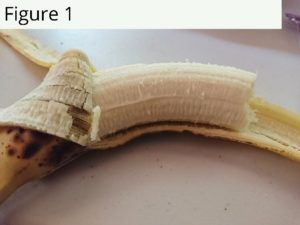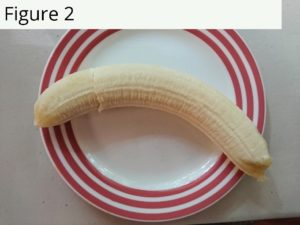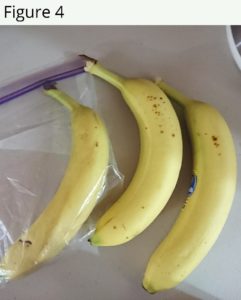Running Head: THE PRESERVATION OF BANANAS IN DIFFERENT TEMPERATURES 1
The Preservation of Bananas in Different Temperatures Compared to the Degradation Rate under Room Temperature
Pitcha Sudjaritjuntorn
The City College of New York
THE PRESERVATION OF BANANAS IN DIFFERENT TEMPERATURES 2
Abstract
Bananas are fruits that are commonly thrown away by consumers on an everyday basis. If bananas are placed in a different area, then they can be preserved for good use. In this experiment, three bananas were placed in three different areas that all vary in temperature for four days. Afterwards, the bananas were examined for any changes in texture, color, and taste. The goal of this experiment was to see whether freezing or refrigeration are more effective ways to preserve bananas in comparison to the degradation rate under room temperature. The results showed that the banana placed in the freezer was the most ineffective method because the banana lost its hard solid shape when it thawed out. However, the banana in the refrigerator showed the best results because the banana looked raw and the taste lacked flavor. Overall, the results of this experiment showed that the most effective way to preserve bananas is by refrigeration because of its moderate cold temperature.
Running Head: THE PRESERVATION OF BANANAS IN DIFFERENT TEMPERATURES 3
Introduction
Bananas are one of the most consumed fruits in the world. They are a very versatile fruit that are used in many recipes. However, it is approximated that the whole world wastes about 1.4 million bananas every day (Minifie, 2014). Most of the time, consumers would throw the bananas away because they turned brown. Therefore, this experiment was conducted for the purpose to determining whether bananas will preserve best in a refrigerator or a freezer in comparison to the degradation rate under room temperature. The hypothesis for this experiment was that if a banana were placed in the freezer, the banana would be preserved and good to eat because it would be in a frozen state. Since food tend to stay preserved and can last longer in the freezer, the banana in the freezer should remain in a similar condition as frozen food as well. By conducting this experiment, it would also be a useful way to save bananas and money.
Running Head: THE PRESERVATION OF BANANAS IN DIFFERENT TEMPERATURES 4
Materials
- Three newly bought average-sized bananas
- A refrigerator
- A freezer
- A countertop or table
- Plates
Methods
On the first day, the controlled banana was placed on a countertop, one banana was placed inside a refrigerator, and another banana was placed inside a freezer. Many times throughout each day, the refrigerator and freezer were opened and closed. After four days, the bananas were taken out and placed on the table for examination. The peels were taken off and the bananas were placed on a plate for comparison. In this experiment, the independent variable was the location of where each banana was placed, the dependent variable was the preservation of the bananas, and the controlled variable was the banana placed on the countertop.
Results
All three bananas changed in appearance on the fourth day of the experiment as shown in figure 5 in comparison to the bananas on the first day as shown in figure 4. The controlled banana resulted in a soft exterior texture of the peel, with some brown dots. The interior was mushy, fragile, and easily could be broken apart as shown in figure 1. The taste was ripe and
Running Head: THE PRESERVATION OF BANANAS IN DIFFERENT TEMPERATURES 5
the smell was strong. The banana in the refrigerator resulted to be hard, cold, and the peel was yellow with some brown dots. The inside of the banana felt hard as if it was newly bought and raw with no black spots or mushy parts as shown in figure 2. The refrigerated banana barely had any taste similar to a raw banana. Lastly, the banana in the freezer resulted in a hard, brown colored peel with no dots or brown spots as shown in figure 5. However, after the banana thawed out, the peel became a mushy, soft texture with liquid inside. The banana was wobbly like a worm and it tasted very sweet. After the banana was peeled, the banana fell into a bowl and formed a circle; there was also water that came from the banana as shown in figure 3.



Running Head: THE PRESERVATION OF BANANAS IN DIFFERENT TEMPERATURES 6


Figure 5- From left to right; controlled banana, refrigerated banana, frozen banana.
Discussion
From this experiment, the changes of bananas after placing them in the freezer and in the refrigerator for four days was observed. However, the results did not support the hypothesis that bananas are best preserved when placed in the freezer because according to the results, the frozen banana did not look like a banana anymore and it was difficult to eat. This suggests that the banana was frozen to the point that all the water in the banana came out and it made the banana lose its form as shown in figure 3. Since bananas originated from hot climate areas, they do not store well in cold temperatures (Builder, 2017). This fact also suggests why the banana placed in the freezer ended up degrading from a hard solid form into a loosely shaped banana.
The banana placed in the refrigerator suggests that the certain temperature of the refrigerator, which is 38 degrees Fahrenheit, is just right for preserving bananas in comparison to the degradation rate under room temperature. The controlled banana on the fourth day was ripe,
Running Head: THE PRESERVATION OF BANANAS IN DIFFERENT TEMPERATURES 7
while the banana in the refrigerator looked and tasted as if it was newly bought from the supermarket. The result of the bananas placed in the refrigerator and the freezer could have been affected by the doors being opened multiple times throughout the four days. Therefore, the results might not be the most accurate.
Conclusion
This experiment helped identify ways that are best for preserving bananas. For future studies, it would be ideal to place the bananas in an unopened refrigerator and freezer. The hypothesis that bananas would be preserved best in the freezer was not supported, therefore, it was concluded that freezing the banana is just as similar as letting the banana degrade under room temperature. Refrigerating the bananas would be the ideal process because the temperature of 38 degrees Fahrenheit is just right and that would preserve the bananas efficiently. By preserving bananas with this method, consumers will be able to waste less bananas as well.
Running Head: THE PRESERVATION OF BANANAS IN DIFFERENT TEMPERATURES 8
Works Cited
Minifie, Kemp. (2014, March 26). Guess How Many Bananas Are Thrown Out Every Day? Retrieved from https://www.epicurious.com/archive/blogs/editor/2014/03/bananas-are-thrown-out-every-day-recipes-and-tips.html
Builder, Maxine. (2017, August 8). How to Store Bananas So They Don’t Turn Black. Retrieved from https://www.myrecipes.com/extracrispy/how-to-store-bananas-so-they-dont-turn-black



